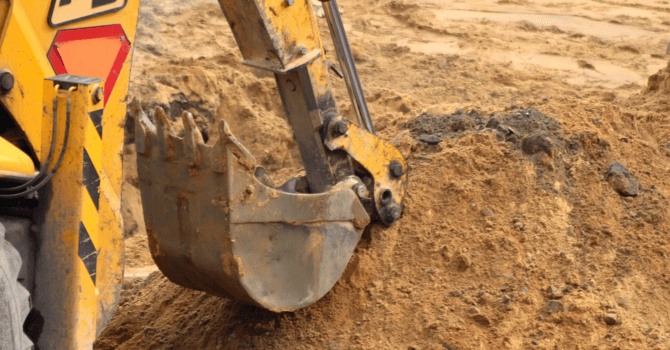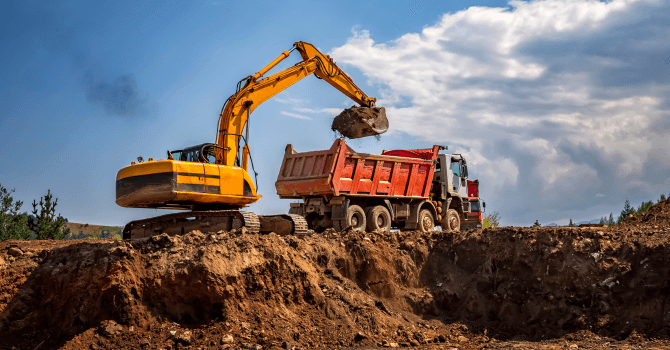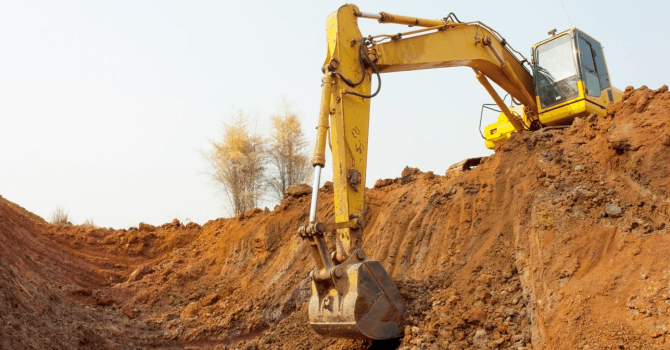
Digging a hole isn’t as easy as it might seem. Hence the reason for excavation standards, which must be adhered to. Abiding by such standards can literally save your life, or that of labourers working alongside you.
Here are the proper methods as well as the right precautionary measures that will prevent you from dealing with a work-related accident on your construction site.
How to Excavate While Adhering to Standards

Source: Canva
Proceeding with an excavation is never deemed a riskless activity. To dig a hole or trench, simply renting an excavator and proceeding with the excavation isn't enough. The risks, which we will cover in the section below, are plenty.
Hence why standards exist. They were established for that reason, to guide you during your excavation work and limit risks of ground collapses and workplace accidents.
The hazards of such a procedure are as real as they come, and for that reason, the CNESST (Commission des normes, de l’équité, de la santé et de la sécurité du travail) has a zero-tolerance policy when it comes to not complying with excavation-related job methods.
As such, we’ll start by listing the standards that must be respected in order to comply with excavation rules, and then we’ll cover the different methods and techniques you can use to carry out shored excavations or trenches.
What are the standards by which to adhere for excavations?
To best way to prevent landfalls is to shore the sides of the excavated hole or trench. However, shoring isn’t always mandatory. Shoring doesn't apply when:
workers aren't called to step inside the excavated hole;
landslides aren’t a risk factor;
slopes are less than 45°; and
the hole is under 3.2 ft (1.20 m) deep.
When made mandatory, Article 3.15.3 of the Safety Code states that construction work requiring shoring must:
surpass excavation limits by 300 mm (12 in);
shoring must be installed gradually while digging; and
be inspected regularly.
On-site, no material must be stocked within 3.3 feet (1.20 m) of the excavated hole, nor should any vehicles be parked within 10 feet (3 m) of the excavation site. Otherwise, should a landslide occur, it will cause the walls of the excavated hole to collapse.
Excavating Shored Trenches: Method and Characteristics

Source: Canva
When excavating a hole or trench, to limit the risks of workplace accidents as much as possible, you have to take precautionary measures each and every step of the way.
1. What should you do prior to excavating?
The first step is to determine the area that will be excavated accurately and put in a “locate request” for underground infrastructures on the Info Excavation website.
Said request allows you to know, within 24 hours, whether there are water, power, or gas lines running beneath your land. Bear in mind that Quebec accounts for 243,000 km of underground cables and pipes. Therefore, you may very likely have some running under your land parcel.
Marking the area where you will be digging also allows you to visualize whether there are suspended power lines above it.
If the latter should be the case, it’s super important for you to know the voltage of the power line in question. Then, with said knowledge, you can determine the distance needed between the power line and excavation equipment:
Under 125,000 volts: 10 ft. (3 m)
125,000 to 250,000 volts: 17 ft. (5 m)
250,000 to 550,000 volts: 27 ft. (8 m)
Over 550,000 volts: 40 ft. (12 m)
Electric arcs are likely to occur within those distances, which could electrocute worksite employees. However, be wary as said distances must be reevaluated and increased if there's rainfall, fog, or snow.
Lastly, when putting together a worksite, note that you’re responsible for the safety of others as well as roadway users. As such, you have to equip your site with the right equipment and put in place all must-have components, such as panels prohibiting parking or establishing an alternate traffic route.
2. How to start excavation work?
Mark the entire underground network and check whether each network owner answered the Info Excavation request you submitted via the website.
Outline the excavation zone or where the trench will be dug.
3. How to dig safely?
When the time comes to start excavating, always keep in mind the piping (if any). Be sure to monitor the depth at which you’re digging.
Make sure the excavator is always at a safe distance from power lines and the excavated material is 3.3 ft. (1.20 m) away from the edges of the dugout.
Once you reach underground infrastructures (if any), a worker can climb into the hole to keep digging with a shovel, provided that the steps detailed below are completed.
4. What should you check prior to climbing into an excavated hole?
Before sending a worker down into the hole, or going yourself, you first have to make sure the trench was shored properly. Also, to ensure the worker isn’t exposing themself to the risk of asphyxia, make sure no vehicle's exhaust system is facing the hole.
The ladder leading into the hole must surpass the edges of the excavated hole or trench by more than 3 ft. (1 m).
5. How can you ensure everyone’s safety during excavation work?
Install a pump at the bottom of the excavated hole or trench to make sure it's always dry. Water can lead to unstable earth, resulting in ground collapses.
Bear in mind that every load moved must be done far away from the workers and never overhead.
If the trench is over 9 ft. (3 m) deep, barricades or guardrails should be installed to prevent falls. Said safety barriers must be at least 2.3 ft. (70 cm) high.
6. How can you remove the shoring safely?
The shoring can be removed once the excavation or trench is completed. Removing said support system too quickly or abruptly can lead to cracking given that the ground experienced too much tension, too fast.
As such, the shoring should always be removed by experienced individuals under the supervision of the worksite’s foreman, and done so according to their guidelines.
What are the risks of carrying out excavation work?

Source: Canva
There are 8 significant hazards to all excavation jobs:
Excavated hole collapsing onto itself
Ground settling
Water damage
Damage caused to neighbouring buildings
Unstable anchors
Dust-related damages
Landslides
Workplace accidents (falls, trench or excavated hole collapsing onto workers, hazardous environment, ruptured pipelines, etc.)
The bigger the trench, the higher the risks. As such, any excavation surpassing 15 ft. (4.5 m), which is considered a deep excavation, leads to greater risks for accidents. By “accident,” we mean damage, but also fatal risks, such as suffocation, internal bleeding, or crush syndrome-related injuries.
What factors cause such risks? Engineers have identified three key risk factors during construction stages: design, construction, and hydrogeology.
Design-Related Risks
The following are considered accident-causing risk factors:
Quality of the concrete (strength, density)
Size of the excavation (depth, width)
Structural support types (fixed, pinned, roller, simple)
Construction-Related Risks
This stage primarily concerns foundations:
Concrete and steel supports aren’t reliable
Timeline-related problems
Failure to comply with specificities related to support installation
Hydrogeology-Related Risk Factors
The factors mentioned below are linked to excavated ground properties:
Presence of a confined aquifer
Level of the phreatic zone (unconfined aquifer)
Earth pressure
Ground’s shear strength
To be more precise, note that a confined aquifer is a pocket of pressurized water surrounded by layers of waterproof materials. Once punctured, it gives way to gushing water known as artesian water. As far as the ground’s shear strength, it refers to the ground’s capacity to withstand landslides when supporting heavy loads.
Get 3 quotes for your excavation-related needs
RenoQuotes.com can help you get quotes for your exterior renovation project. When you submit your project, we’ll put you in contact with top-rated contractors. Fill in the form on the homepage (it only takes a few minutes) and receive quotes from companies specializing in home renovations.
Dial 1-844 828-1588 to speak with one of our customer service representatives.
Looking for something else?
Related articles
The latest industry news, interviews, technologies, and resources.

Editorial Team
•16 May 2024
Is your deck finally ready but you’re still on the fence about what kind of railing best suits what you’re looking for?

Editorial Team
•07 Nov 2023
Keeping a balcony well maintained can be difficult! Your balcony hangs outside all day and night, sitting in the open air. As a result, it is susceptible to the various elements, collecting copious amounts of dirt and dust. Grime flies up from the adjacent street, birds set up their nests in its nooks, rain and snow come and go...

Editorial Team
•23 Jul 2025
Choosing the right paint or stain for your deck is key to ensuring its durability and aesthetic. Whether partial to stain or paint, wood or concrete, this buying guide will help you navigate the array of options available. Learn how to prepare your surface and choose the best product to revamp this outdoor space.

Cynthia Pigeon
•07 Nov 2023
Even though your garage’s primary function is to shield your vehicle(s) from adverse weather conditions, it can also be used for storage. However, before long, you'll need to optimize your space as more items will start to pile up. As such, there are many things to consider regarding overhead storage in your garage. Overhead garage storage is one of the absolute best ways to keep your space clutter-free, while also maximizing its use. And, you'll soon notice just how much of a difference this alternative makes!

Editorial Team
•26 Jul 2024
If you're hoping to update your kitchen but don't want to break the bank, there are some simple ways that you can add flair and personal touch to your space. You might want to start with your kitchen's backsplash.